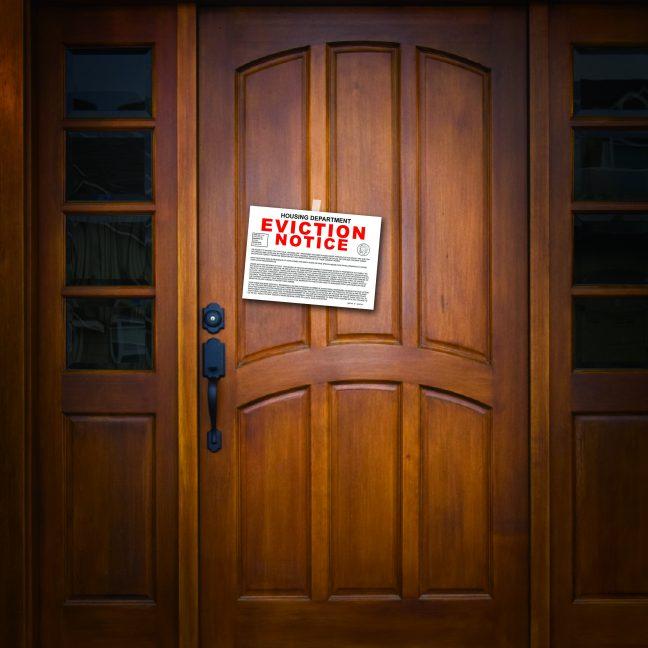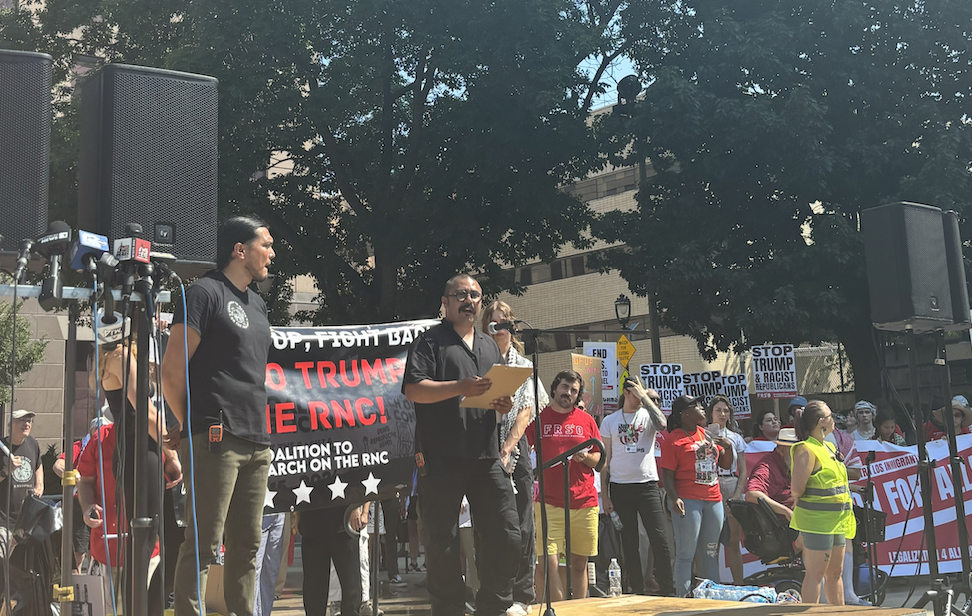As images of Milwaukee riots made the national newscasts, so did one often-cited statistic: Milwaukee, the largest city in Wisconsin, is one of the most segregated cities in the country.
Some striking numbers on poverty and incarceration also made headlines. More than half of black men in their 30s and 40s in Milwaukee have been incarcerated and more than 40 percent of people in central Milwaukee live in poverty.
But one issue that hasn’t garnered as much attention is eviction and the role it plays in destabilizing communities.
When riots spread across Milwaukee’s north side after a police officer shot and killed a black man Aug. 13, people around the world asked why the particular shooting resulted in such a violent response.
State Sen. Lena Taylor, D-Milwaukee, called Sylville Smith’s shooting the “straw that broke the camel’s back,” and said the protests that followed in the Sherman Park neighborhood were the result of a breaking point following the build up of traumatic events.

“The hopelessness that exists for some people because of the trauma on trauma, the lack of opportunities on lack of opportunities, has created a … pressure point that created [the riots] and if we don’t fix that, we are going to have the same problem again,” Taylor said.
Until recently, a link between eviction and crime was impossible to back up — academia in America had all but ignored the study of eviction. That changed when sociologist and University of Wisconsin alumnus Matthew Desmond stepped in.
In an interview with The Badger Herald, Desmond said eviction threatens community stability and vulnerable citizens living in poverty in Milwaukee.
“When you thwart the possibility of a community becoming a community, through evictions, it can really breed an environment for heightened crime and we found that in Milwaukee,” Desmond said.
Desmond first began researching eviction while completing his dissertation at UW. He received his doctorate from UW in 2010 and now works as an associate professor of sociology and social studies at Harvard University.
During his time at UW, there was only one person besides Desmond in the country studying eviction at that time, Tim Smeeding, UW professor of public affairs and economics, said.
“There were a lot of people studying foreclosure, people losing their homes that they own because they couldn’t pay their mortgages,” Smeeding said. “But there was very little on the process by which renters are tossed out of their homes.”
Telling the ‘American story’ of eviction
Desmond’s research resulted in “EVICTED: Poverty and Profit in the American City,” a novel that follows eight families and their experiences with eviction in Milwaukee. It was chosen as UW’s 2016-17 Go Big Read book.
Desmond lived in Milwaukee for more than a year, first in a trailer park then in an inner city boarding house, to conduct research for “EVICTED.” Desmond also followed the experience of two landlords in Milwaukee to capture a broad picture of housing insecurity.
“I knew that to really understand the dynamics of the low income housing market, to really understand what was going on out there in some of our poorest communities, I needed to get the landlord’s perspectives too,” Desmond said.
By including the landlords’ stories, Desmond said he can ensure people won’t fall back on “simplistic narratives about tenants being lazy or landlords being greedy.”
Desmond decided to research eviction in Milwaukee because it represents what people of moderate means are going through in cities across the country.
“I wanted to understand the role that housing plays in creating poverty in America and the role it could play in reducing poverty and social suffering in our cities,” he said. “‘EVICTED’ is a Milwaukee book, but it tells an American story.”
Milwaukee is extremely segregated, Smeeding said, and race and socioeconomic status work together to contribute to frequent evictions.
“Poor black men are locked up; poor black women are locked out.”
Desmond found that among Milwaukee renters, more than one in five black women have been evicted in their lifetime, compared to one in 15 white women.
“In poor black neighborhoods, what incarceration is to men, eviction is to women: a common yet consequential event that pushes families deeper below the poverty line,” Desmond said in a statement. “Poor black men are locked up; poor black women are locked out.”
Challenges to employment after imprisonment incite movement to change application process
Community instability
Desmond said his book attempts to answer whether neighborhoods with more evictions have more violent crime the following year.
Through his research in Milwaukee, Desmond found this to be the case. Eviction and incarceration do not just impact individuals, but have consequences on communities as a whole.
When neighbors work together they can drive down crime in their community and organize to address problems, Desmond said. But many neighbors remain strangers due to housing instability and the power of community becomes diluted.
“Eviction really threatens the social fabric of a community,” Desmond said. “We don’t let those communities reach their full potential. If we want more community stability, if we want more community engagement, we need fewer evictions.”
In photos: A look into wreckage one month after Milwaukee riots

It is important to place the recent riots in a broad historical and sociological context, Desmond said, and the lack of affordable housing and the history of housing instability is part of that context.
Taylor believes the issue of eviction in Milwaukee is linked to the high rate of incarceration because when one person is incarcerated part of a household’s income is taken away and the burden of paying rent then falls on a single income.
Taylor said traits like high incarceration rates, low literacy rates, high unemployment rates and infant mortality rates comparable to third world countries make Milwaukee “own the label of the worst place in the nation to raise a black child.”
Taylor said the problems persist because they are happening to the “economically poor who are voiceless.”
“We have to own what our truth is,” she said. “We are the most segregated city in the nation. We have some of the greatest disparities that exist in the nation.”
An under-researched field
Eviction is so under-researched across the country that basic questions about the topic don’t have answers yet, including whether Madison’s eviction rates are comparable to Milwaukee’s, Desmond said.
While Desmond was living in Milwaukee and listening to tenants’ experiences with eviction, he was also conducting a study that collected and analyzed years of statistical data about poverty, housing and displacement.
“Evictions, which used to be rare in this country and draw crowds, have become a normal and regular part of living below the poverty line.”
Often, landlords don’t make their evictions legal because it requires getting a lawyer and the legal process takes time, Smeeding said.
Legally, a tenant in Wisconsin can only be forced to leave their home after a court date where the judge rules in the landlord’s favor, according to the Tenant Resource Center’s website. Landlords cannot change locks or remove a tenant’s belongings and a sheriff is the only person who can physically remove a tenant from a property.
Landlords go about illegally evicting tenants in two ways, Smeeding said.
“A good landlord will say, ‘I’ll give you a hundred bucks to be out by the end of the week,’” Smeeding said. “A bad landlord will say, ‘If you’re not out by the end of the week, I’m gonna unscrew your front door.’”
Desmond’s study of Milwaukee encompassed both legal and illegal evictions. Because so many evictions happen illegally, it is difficult to find true eviction data on cities across the country.
Desmond has recently examined eviction data in Cleveland, Kansas City, Missouri, Chicago and New York City. National eviction data shows that renters in more than 2.8 million homes think they’ll be evicted soon, Desmond said.
“The kinds of numbers that we saw in Milwaukee are sadly the kind of numbers we’re seeing in other cities,” Desmond said. “And it means that if we want more family stability we have to have fewer evictions.”
Strengthening communities through public housing
According to Desmond’s research, most Americans spend 30 percent of their income on housing. But the majority of poor renting families spend more than half of their income on housing. At least one in four of those families spend more than 70 percent of their income on housing.
“Evictions, which used to be rare in this country and draw crowds, have become a normal and regular part of living below the poverty line,” Desmond said.
Public housing helps combat eviction and housing instability to an extent, because landlords are guaranteed their rent will get paid, Smeeding said. In public housing, a tenant’s rent is consistently 30 percent of their current income, he said.
Finding public housing in a “less concentrated poverty area” improves living conditions for children and improves opportunities for parents as well, Smeeding said.
Unfortunately, there are not enough public housing vouchers for everyone that needs one, Smeeding said. For every four or five people who are eligible for a public housing unit, there is one unit available, he said.
“We have to come to terms with both the promise and the peril of a city like Milwaukee,” Desmond said. “That kind of dual face comes to characterize the city and captures the texture of America and that should give us hope.”



















